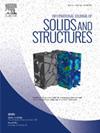Bending and vibration analyses of functionally graded auxetic doubly curved shells via dual mesh control domain model
IF 3.4
3区 工程技术
Q1 MECHANICS
International Journal of Solids and Structures
Pub Date : 2025-06-14
DOI:10.1016/j.ijsolstr.2025.113526
引用次数: 0
Abstract
This paper presents a novel dual mesh control domain (DMCD) model for the static bending and free vibration analysis of functionally graded (FG) graphene origami (GOri)-enabled auxetic metamaterial (GOEAM) doubly curved shells within the framework of the first-order shear deformation theory and modified Sanders assumptions. The shell consists of multilayered GOEAMs where the GOri content varies across the shell thickness in a layer-wise manner, leading to graded variations in auxetic and other material properties. Genetic programming (GP)-assisted micromechanical models are employed to estimate the material properties, including Poisson’s ratio, Young’s modulus, coefficient of thermal expansion (CTE), and mass density of the GOEAM in each layer. Governing equations are derived by the principle of virtual work and numerically solved using the dual mesh control domain method (DMCDM). The accuracy and convergence of the DMCD model are first verified, followed by a systematic investigation of the effects of GOri content, folding degree, temperature, and length-to-thickness ratio on the bending deflection, normal stress and fundamental frequency of FG-GOEAM doubly curved shells. The numerical results provide valuable insights for designing FG-GOEAM doubly curve shells in aerospace engineering with tunable negative Poisson’s ratio and enhanced mechanical properties.
基于双网格控制域模型的功能梯度退化双弯曲壳的弯曲和振动分析
在一阶剪切变形理论和修正的Sanders假设框架下,提出了一种新的双网格控制域(DMCD)模型,用于功能梯度(FG)石墨烯折纸(GOri)激活的auxetic超材料(GOEAM)双弯曲壳的静态弯曲和自由振动分析。壳层由多层goeam组成,其中GOri含量随壳层厚度的变化而变化,从而导致材料的auxtic和其他性能的梯度变化。采用遗传规划(GP)辅助微力学模型估计材料性能,包括泊松比、杨氏模量、热膨胀系数(CTE)和每层GOEAM的质量密度。利用虚功原理推导了控制方程,并采用双网格控制域法(DMCDM)进行了数值求解。首先验证了DMCD模型的准确性和收敛性,然后系统地研究了GOri含量、折叠程度、温度和长厚比对FG-GOEAM双弯曲壳的弯曲挠度、正应力和基频的影响。数值结果为设计具有可调负泊松比和增强力学性能的FG-GOEAM双曲线壳在航空航天工程中的应用提供了有价值的见解。
本文章由计算机程序翻译,如有差异,请以英文原文为准。
求助全文
约1分钟内获得全文
求助全文
来源期刊
CiteScore
6.70
自引率
8.30%
发文量
405
审稿时长
70 days
期刊介绍:
The International Journal of Solids and Structures has as its objective the publication and dissemination of original research in Mechanics of Solids and Structures as a field of Applied Science and Engineering. It fosters thus the exchange of ideas among workers in different parts of the world and also among workers who emphasize different aspects of the foundations and applications of the field.
Standing as it does at the cross-roads of Materials Science, Life Sciences, Mathematics, Physics and Engineering Design, the Mechanics of Solids and Structures is experiencing considerable growth as a result of recent technological advances. The Journal, by providing an international medium of communication, is encouraging this growth and is encompassing all aspects of the field from the more classical problems of structural analysis to mechanics of solids continually interacting with other media and including fracture, flow, wave propagation, heat transfer, thermal effects in solids, optimum design methods, model analysis, structural topology and numerical techniques. Interest extends to both inorganic and organic solids and structures.

 求助内容:
求助内容: 应助结果提醒方式:
应助结果提醒方式:


